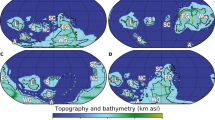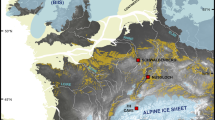Abstract
CONTINENTS can be positioned in their earlier places on the Cainozoic globe by means of their rock magnetism; continents for which such data are lacking can be placed in their relative positions by removing the subsequently generated seafloor. On such a reconstructed globe for a particular time in the Cainozoic the distribution of palaeoclimates, as deduced from significant rock-types and fossil plants and animals, can be plotted in their true geographical relationships. Locations of the continents and subcontinents with respect to the rotational coordinate system, as well as to each other, will largely determine the prevailing climatic trends by affecting the circulation patterns in oceans and atmosphere. Here we attempt to model, in a semi-quantitative way, the climates of the Earth in the later half of the Eocene (40–48 m.y. ago) and in the early half of the Oligocene (30–37 m.y. ago), an interval of marked climatic change.
This is a preview of subscription content, access via your institution
Access options
Subscribe to this journal
Receive 51 print issues and online access
$199.00 per year
only $3.90 per issue
Buy this article
- Purchase on Springer Link
- Instant access to full article PDF
Prices may be subject to local taxes which are calculated during checkout
Similar content being viewed by others
References
Creer, K. M., J. Geophys. Res., 67, 3461 (1962).
Jardine, N., and McKenzie, D., Nature, 235, 20 (1972).
McElhinny, M. W., and Wellman, P., Earth Planet. Sci. Lett., 6, 198 (1969).
Creer, K. M., Earth Sci. Rev., 6, 369 (1970).
Wellman, P., and McElhinny, M. W., Nature, 227, 595 (1970).
Dickson, G. P., Pitman, III, W. C., and Heirtzler, J. R., J. Geophys. Res., 73, 2087 (1968).
Weissel, J. K., and Hayes, D. E., in Antarctic Oceanology (edit. by Hayes, D. E.), 2 (Amer. Geophys. Union, Washington, DC, in the press).
Griffiths, J. R., and Varne, R., Nature Physical Science, 235, 83 (1972).
Davies, H. L., and Smith, I. E., Geol. Soc. Amer. Bull., 82, 3299 (1971).
Dalziel, I. W. D., and Elliot, D. H., Nature, 233, 246 (1971).
Dorman, F. H., J. Geol., 74, 49 (1966).
Devereaux, I., NZ J. Sci., 10, 988 (1967).
Douglas, R. G., and Savin, S. W., in Initial Reports of the Deep Sea Drilling Project, 6, 1123 (1971).
Sverdrup, H. U., Johnson, M. W., and Fleming, H. R., The Oceans (Prentice Hall, New York, 1942).
Wolfe, J. A., and Hopkins, D. M., in Tertiary Correlations and Climatic Changes in the Pacific, 67 (Eleventh Pacific Sci. Congr., Tokyo, 1967).
Schwarzbach, M., Z. Deutsch. Geol. Ges., 118, 33 (1968).
Tanai, T., J. Fac. Sci., Hokkaido Univ., 19, 384 (1970).
Lamb, H. H., in Descriptive Paleoclimatology (edit. by Nairn, A. E. M.), 8 (Interscience, New York, 1961).
Frakes, L. A., and Kemp, E. M., in Continental Drift, Sea Floor Spreading and Plate Tectonics—Implications for the Earth Sciences (edit. by Tarling, D. H.) (Univ. of Newcastle upon Tyne, in the press).
Reid, E. M., and Chandler, M. E. J., The Flora of the London Clay (Brit. Mus. Nat. Hist., London, 1933).
Daley, B., Palaeogeogr., Palaeoclim., Palaeoec., 11, 177 (1972).
Wolfe, J. A., Palaeogeogr., Palaeoclim., Palaeoec., 9, 27 (1971).
Couper, R. A., Palaeont. Bull., 32, 1 (1960).
Wilson, G. J., NZ J. Botany, 6, 56 (1968).
McIntyre, D. J., and Wilson, G. J., NZ J. Botany, 4, 315 (1966).
Dury, G. H., Geogr. J., 137, 511 (1971).
Millot, G., Geology of Clays; Weathering, Sedimentology, Geochemistry (Springer Verlag, New York, 1970).
Harder, E. C., Geol. Soc. Amer. Bull., 60, 887 (1949).
Axelrod, D. I., and Bailey, H. P., Palaeogr., Palaeoclim., Palaeoec., 6, 163 (1969).
Kobayashi, T., and Shikama, T., in Descriptive Climatology (edit. by Nairn, A. E. M.), 292 (Interscience, New York, 1961).
Vlasov, G. M., Dokl. Akad. Nauk SSR, 157, 589 (1964).
Squires, D. F., NZ Geol. Surv. Palaeont. Bull., 29 (1958).
Crowell, J. C., and Frakes, L. A., Amer. J. Sci., 265, 193 (1970).
Author information
Authors and Affiliations
Rights and permissions
About this article
Cite this article
FRAKES, L., KEMP, E. Influence of Continental Positions on Early Tertiary Climates. Nature 240, 97–100 (1972). https://doi.org/10.1038/240097a0
Received:
Issue Date:
DOI: https://doi.org/10.1038/240097a0
This article is cited by
-
Evidence for deep-water production in the North Pacific Ocean during the early Cenozoic warm interval
Nature (2004)
-
Evolution of the Indian Ocean and the drift of India: A vicariant event
Hydrobiologia (1987)
-
Continental distribution as a forcing factor for global-scale temperature
Nature (1984)
-
A review of the fossil record of monocotyledons
The Botanical Review (1981)
-
Paleogeography as a climatic forcing factor
Geologische Rundschau (1981)
Comments
By submitting a comment you agree to abide by our Terms and Community Guidelines. If you find something abusive or that does not comply with our terms or guidelines please flag it as inappropriate.



